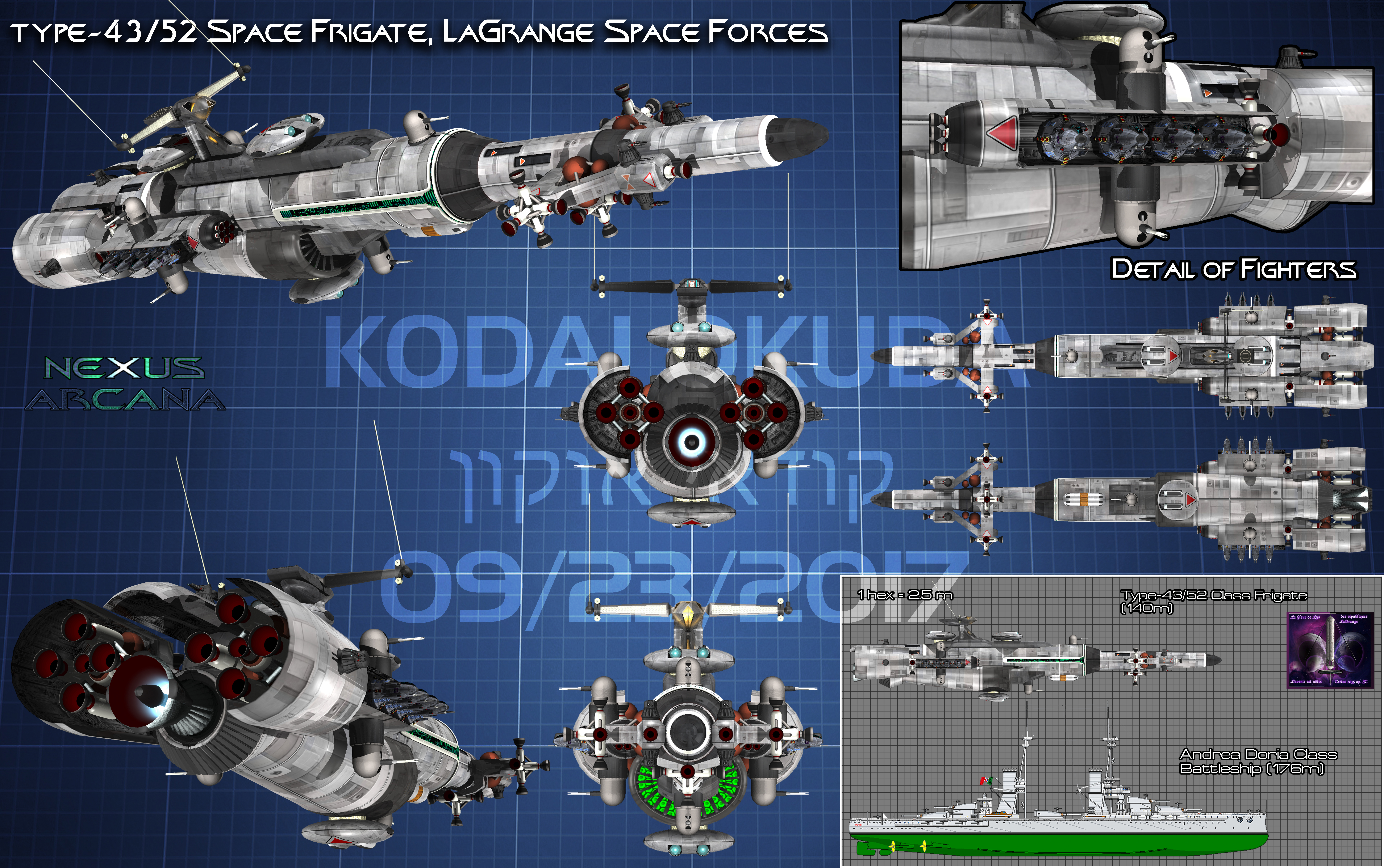SPECIFICATIONS

GOVERNMENT: LaGrange Colonial Republics
TYPE: Space Frigate
MODEL: Type-43/52 class
DATE INTRODUCED: 2143 AD (refit 2152 AD to combat status)
LENGTH: 459.3 feet (140 meters)
WIDTH: 98.4 feet (30 meters)
HEIGHT: 114.8 feet (35 meters)
MATERIAL: Kevlar Composite
POWER PLANT: Belgarde Fusion Reactor BFR-4M
OUTPUT: 4,000,000 kilowatts (4000 megawatts)
ARMOR TYPE: Composite Alloy
ARMOR THICKNESS: 3 inches
DISPLACEMENT: 5000 tons
CREW: 112 (5 Pilots, 33 Gunners, 5 Technicians, 5 Electricians, 12 Engineers, 9 Officers, 5 Medical, 10 science, 20 security, 8 space fighter pilots)
PROPULSION
INTERPLANETARY:
1x OTRAG HYIE-1500 High Yield Ion Engine
SPEED: 3040 MPH
POWER REQUIRED: 1500 megawatts
PRIMARY:
27x OTRAG NEE-200-M10 nuclear electric engines
SPEED: 121.65 mph each (Delta-V of each vector: 1216.5 mph forward, 243.3 mph port/starboard/ventral/dorsal, 608.25 mph reverse speed)
FUEL: 206.4 minutes each engine (3.4 hours)
AUXILLIARY:
12x OTRAG NEE-200-M.9
SPEED: 20 mph each (Delta-V by arc: 144 mph each vector)
FUEL: 93 minutes each engine
WEAPONS:
ASSAULT:
3x Renault Research FF-LC-80 dual 40-megawatt laser cannon turrets; Effective Range: 400 miles; Payload: unlimited; Rate of Fire: 1 dual blast per 10 seconds (6 dual blasts per minute) each turret
PRIMARY (OFFENSIVE):
6x Bofors AC-S105 (105-millimeter) turrets; Effective Range: 6 miles; Payload: 150-round autoloading mechanical tray; ROF: up to 30 rounds per minute.
SECONDARY (OFFENSIVE):
7x Bophors AC-502S dual-50mm autocannon turrets; Effective Range: 1.4 miles; Payload: 200 rounds each; ROF: bursts of 4,10, or 20 rounds in two seconds with a cyclic rate of up to 600 rounds per minute.
BALLISTIC:
8x Bohing STL-02; Missile Type: MHST-01 2000-pound SMART-guided space torpedo with 38.2-Kiloton yield nuclear warhead; Effective Range: 27 miles; Payload: 10 space torpedoes each; ROF: 1 torpedo each launcher every 2 seconds (up to 30 per minute).
ELECTRONICS:
1x Radio Communications array with a 100,000-mile range.
1x Microwave radio Communications array with a 100,000-mile range.
1x RADAR sensor array with a range of 200,000 miles.
1x Tesla-Shauberger Gravitational Control Unit (after 2055 AD): Effect: provides both gravity within the vessel, antigravity for assisted take off, and g-force compensation for high-g flight.
DEFENSE SYSTEMS:
1x En Garde Inc. EG-ES-2500 2500-kilowatt electrostatic armor generator; RANGE: 15 feet; Effect: provides an electric armor that nullifies explosive weapons, and greatly reduces projectile weapon damage.
CARGO BAY:
1x 1976 yd3 Bay holds 5 years of food and supplies for the crew (missions were rarely more than 3 years for this vessel).
MOBILE WEAPONS:
8x Type-44 space fighters carried outside the ship and moored via grappling anchors.
DESCRIPTION:
The Type-43 construction spacecraft (original ship):
A ship built off of the Saturn XXII model heavy lift thermonuclear rocket of the early 2140s, the Type-43/52 was the most advanced vessel of the 2150s in terms of space warship design. Like all of the LaGrange designed spacecraft, the Type-43/52 was not initially a warship. As a Saturn XXII heavy lift vehicle it had three electromagnetic tractor-beam/repulsor-beam cranes that were used to move the large solar panels of the O'Neil Type cylindrical colonies into place in the L4 and L5 regions of the Earth-Moon Sphere. It had fifteen thermonuclear rocket motors for forward thrust, and fifteen retros to stop on a proverbial dime in space. A unique feature--for a ship built in 2143--was the tower style bridge that allowed crane operators the ability to better maneuver the huge solar panels into place during both repair and construction. The Bridge section also had a landing pad for exosuits and small work pods. Shuttle craft could also dock magnetically to the pad and allow passengers or crew to disembark onto the bridge of the Type-43.
The Type-43/52 Space Frigate:
The modifications to the original Type-43 by the LaGrange Republics was in response to the outbreak of the Great War and the introduction of space warships by both the United States Space Navy and United Nations Space Corps. The Type-43 was modified in 2152 AD to house a high yield ion engine as its main drive in place of five of the thermonuclear rockets (one cluster of 5, and booster array, was removed from the ventral side of the fuselage). The Ion Engine gave the ship unprecedented speed and range, but the lack of a Tesla-Shauberger Gravitational Control Unit on early vessels limited the speed of the craft greatly. This problem was corrected in 2155 with the advent of the Tesla-Shauberger system by members of the United States Space Navy team helping the LaGrange scientists decipher the alien technology of the L4-2135 object that LaGrange had at the L4 colony. The three electromagnetic cranes were replaced with three dual, 80-megawatt laser cannons (6 lasers total). These laser cannon batteries were the primary armaments of the ship and used mostly against AS-03 or larger UNSC ships. The secondary anti-ship/space station weapons consisted of eight space torpedo tubes that fired the USSN made MHST-01 found on the Kentucky Class Assault Shuttle and many subsequent Earth Federal Republic vessels of the late 2160s and 2170s. Six 105mm autocannons were mounted to the vessel to act as an anti-assault shuttle screen. Anti-space fighter emplacements were also added in to the form of seven, dual-barrel, 50mm autocannon turrets in key locations on the ship. With such an impressive array of weaponry the Type-43/52 was a formidable spacecraft. It was fitted with electrostatic armor as its last line of defense. Additionally, eight Type-44 space fighters were added to the ship to act as an anti-space fighter/shuttle and anti-missile defense.
It should be noted that a total of 90 Type-43/52s were constructed from 2152 to 2162 in the L4 and L5 LaGrange Republic colonies, and that this craft was the direct predecessor to the Juno Class space frigate built by the USSN in 2162. All 90 Type-43/52s were converted to Junos during the 2160s and all fought in the 1st Interplanetary War during the Solar Empire's attempted invasion of the Earth-Moon Sphere. Many of these ships served with the Earth Federal Republic Space Navy and subsequent Planetary Alliance Space Navy well into the 2190s.


